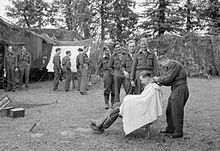No. 65 Squadron RAF
This article includes a list of generalreferences,butit lacks sufficient correspondinginline citations.(August 2010) |
| No. 65 (East India) Squadron RAF | |
|---|---|
| Active | 1 August 1916 (RFC) to 1919 1934–1961 1964–1970 1970–1974 1986–1992 |
| Country | |
| Branch | |
| Motto(s) | Latin:Vi et armis "By force and arms"[1] |
| Battle honours | Western Front, 1917-1918*: Cambrai, 1918*: Somme, 1918*: France & Low Countries*: Dunkirk: Battle of Britain, 1940*: Home Defence, 1940-42: Fortress Europe, 1941-1944*: Channel & North Sea, 1942-1945*: Dieppe: Normandy, 1944: Arnhem: France & Germany, 1944-1945*: Baltic 1945: Honours marked with an asterisk are those emblazoned on the Squadron Standard |
| Insignia | |
| Squadron Badge heraldry | In front of fifteen swords in pile, the hilts in base, a lion passant.[2] The number of swords refers to a memorable combat in which fifteen enemy aircraft were destroyed. |
| Post 1950 Squadron Roundel |  |
No. 65 Squadronwas asquadronof theRoyal Air Force.
First World War
[edit]The squadron was first formed atWytonon 1 August 1916 as a squadron of theRoyal Flying Corpswith a core provided from the training station atNorwich.[3]It served as a training unit as part of the Norwich based No. 7 Training Wing until equipping withSopwith Camelsand transferring to France as an operational fighter squadron in October 1917.[4][5]By the end of theFirst World War,it had claimed about 200 victories. Thirteen aces had served with it, including: John Inglis Gilmour, Joseph White, Maurice Newnham, Thomas Williams, William Harry Bland, Alfred Leitch, Jack Armand Cunningham, Godfrey Brembridge,and George M. Cox.[6] Arthur G. Jones-Williams,who would go on to long-range flight record attempts in 1929, also served in the squadron.[7]
Second World War
[edit]
The squadron reformed in 1934 atRAF Hornchurchwith theHawker Demon,converting to theGloster Gauntletin 1936 and theGloster Gladiatorin 1937.[8]DuringWorld War II,the squadron operatedSupermarine Spitfires,having converted from Gladiators in 1939. In December 1943, the squadron converted toNorth American Mustangs.For a period of time theirWing CommanderwasReg Grant.[9].
Post war
[edit]In 1946, the unit converted to the Spitfire LF.XVIe and then thede Havilland Hornet,theGloster MeteorF.4 and F.8, then theHawker HunterF.6 (December 1956) at RAF Duxford from August 1952 until the squadron disbanded on 31 March 1961, and then reformed in 1964 as asurface-to-air missileunit, operating theBristol Bloodhound.During this period, it was based atRAF Seletar,Singapore,and it disbanded again in 1970. From 1970, No. 65 Squadron became the reserve squadron number forNo. 226 Operational Conversion Unit RAFat RAF Coltishall, until its disbandment in the mid 1970s. It was thereafter the reserve squadron number ofNo. 229 Operational Conversion Unit RAFat RAF Coningsby. It was last disbanded atRAF Coningsbyin June 1992, by re-numbering asNo. 56 (Reserve) Squadron,after serving as theOperational conversion unitfor thePanavia Tornado F.2 and F.3interceptor, with the alternative identity ofNo. 229 Operational Conversion Unit RAF.
References
[edit]Citations
[edit]- ^Pine, L.G. (1983).A dictionary of mottoes(1 ed.). London: Routledge & Kegan Paul. p.250.ISBN0-7100-9339-X.
- ^Poulsen, C M, ed. (2 September 1937). "RAF Unit Badges".Flight International.32(1, 497): 235.ISSN0015-3710.
- ^Halley 1988,p. 130.
- ^Rawlings 1969,p. 158.
- ^Sturtivant, Hamlin & Halley 1997,p. 311.
- ^Shores, Franks & Guest 1990,p. 65.
- ^Shores, Franks & Guest 1990,pp. 217–218.
- ^Gustavsson, Håkan."Gloster Gladiator in 65 RAF Squadron service".Biplane Fighter Aces from the Second World War.Retrieved17 April2013.
- ^NZFPM 2010.
Bibliography
[edit]- NZFPM (2010)."Wing Commander Grant".Archived fromthe originalon 25 May 2010.Retrieved25 May2010.
- Halley, James J (1988).The Squadrons of the Royal Air Force and Commonwealth 1918–1988.Tonbridge, UK: Air-Britain (Historians) Ltd.ISBN0-85130-164-9.
- Jefford, C.G. RAF Squadrons, a Comprehensive Record of the Movement and Equipment of all RAF Squadrons and their Antecedents since 1912. Shrewsbury: Airlife Publishing, 1998 (second edition 2001).ISBN1-84037-141-2.
- Rawlings, John D. R. (1969).Fighter Squadrons of the R.A,F. and their Aircraft.London: Macdonald & Co. (Publishers) Ltd.
- Shores, Christopher; Franks, Norman; Guest, Russell (1990).Above The Trenches: A Complete Record of the Fighter Aces and Units of the British Empire Air Forces 1915–1920.London: Grub Street.ISBN0-948817-19-4.
- Sturtivant, Ray; Hamlin, John; Halley, James J. (1997).Royal Air Force Training and Support Units.Tunbridge Wells, UK: Air-Britain (Historians) Ltd.ISBN0-85130-252-1.
